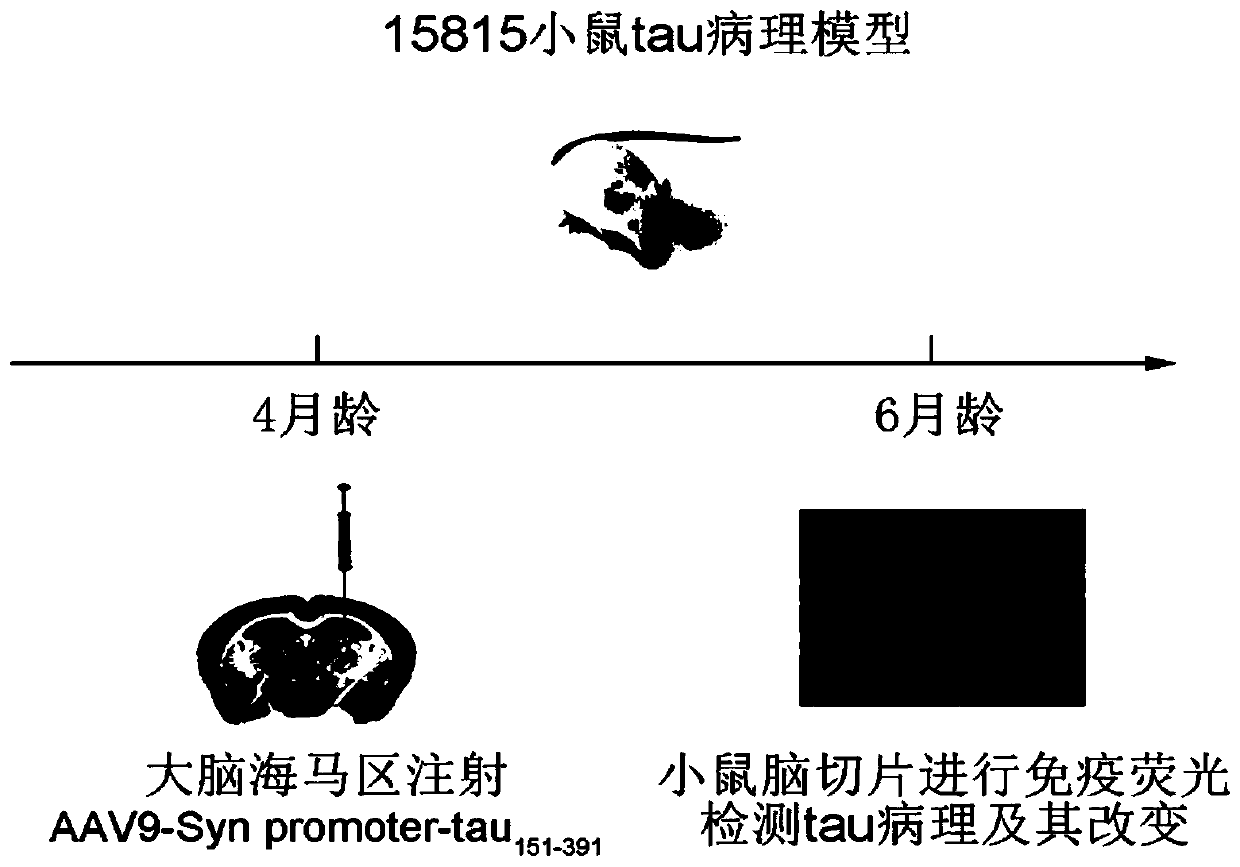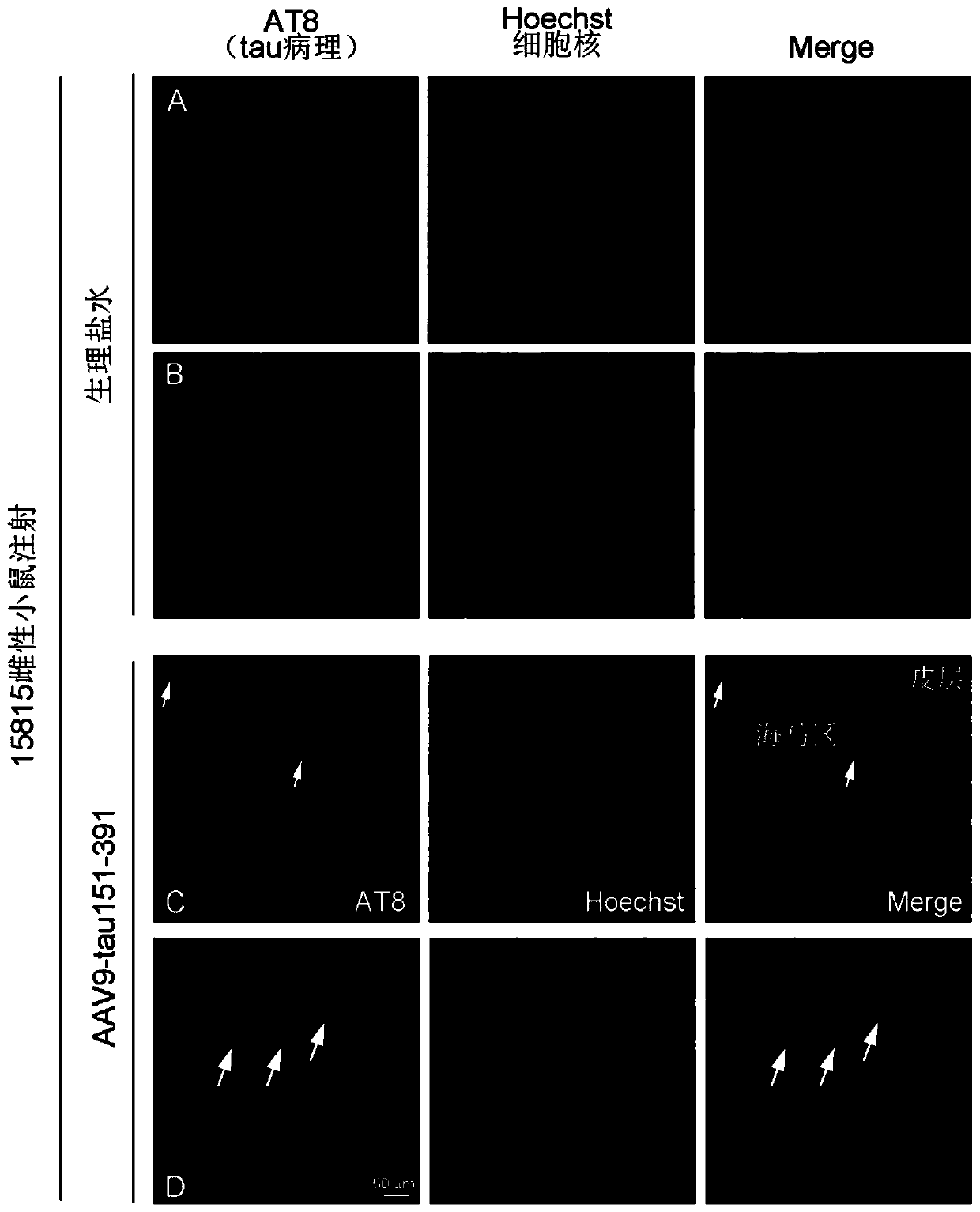Method for constructing Alzheimer disease mouse model
An Alzheimer's disease and mouse model technology, applied in the field of biomedicine, can solve problems such as being unsuitable for large-scale drug screening, the model making cycle is too long, and the spread of tau pathology cannot be observed.
- Summary
- Abstract
- Description
- Claims
- Application Information
AI Technical Summary
Problems solved by technology
Method used
Image
Examples
Embodiment 1
[0022] Example 1 Construction of Alzheimer's disease mouse model
[0023] Viral vectors integrating human tau protein truncations tau151-391, tau1-150, tau392-441 and tau protein were respectively constructed. The amino acid sequence of tau151-391 protein is shown in SEQ ID NO:1, and the DNA sequence is shown in SEQ ID NO:2; the amino acid sequence of tau1-150 protein is shown in SEQ ID NO:3, and the DNA sequence is shown in SEQ ID NO: 4; the tau392-441 protein amino acid sequence is shown in SEQ ID NO: 5, and the DNA sequence is shown in SEQ ID NO: 6; the tau protein amino acid sequence is shown in SEQ ID NO: 7, and the DNA sequence is shown in SEQ ID NO:8 shown.
[0024] The hSyn promoter-MCS-EGFP-3FLAG-SV40 PolyA virus vector was constructed, the full-length human tau protein and the corresponding DNA sequences of each truncated body were integrated, and the adeno-associated virus AAV9 was packaged.
[0025] According to the human tau protein truncated tau151-391, tau1-15...
Embodiment 2
[0065] Example 2 Pathological detection of rat brain tau
[0066] The sagittal 40 μM thick tissue sections of the brains of 15815 mice injected with different groups of viruses were washed with PBS, treated with PBS containing 0.5% Triton-X 100, and blocked with 5% goat serum blocking solution for 30 minutes, targeting phosphorylated tau (tau Pathology) specific antibody mouse-AT8 1:1000 was incubated overnight at 4 degrees, washed 3 times with PBS, Alexa-555 fluorescently labeled anti-mouse secondary antibody was incubated at room temperature for 2 hours in the dark, added 1:5000 Hochest for 15 minutes, washed three times with PBS, Patch cover. Fluorescence microscopy to detect tau pathology. The result is as Figure 2-4 As shown, the results show that 15815 female mice were injected with AAV9-tau151-391 in the brain at the age of 4 months, and at the age of 6 months, they were stained with AT8, a specific antibody for phosphorylated tau at the Ser202 / Thr205 site, to mark t...
Embodiment 3
[0069] Embodiment 3. The application example of mouse tau pathological model described in the present invention
[0070] (1) Screening genes that can inhibit tau pathology.
[0071] The target gene adeno-associated virus vector was constructed and injected into the hippocampus of 4-month-old 15815 mice to highly express the target gene. Two weeks later, AAV9-tau151-391 virus was injected at the same location to induce tau pathology. At the age of 6 months, the mouse brain was taken for immunofluorescence, and the intensity of tau pathology (the number of tau pathology-specific antibody mouse-AT8 positive cells) was compared between the mice injected with the target gene virus and the control virus, to determine whether the target gene affected the occurrence of tau pathology, In this way, genes that can effectively inhibit tau pathology are screened out.
[0072] (2) Screening drugs that can inhibit tau pathology
[0073] AAV9-tau151-391 virus was injected into the hippocam...
PUM
 Login to View More
Login to View More Abstract
Description
Claims
Application Information
 Login to View More
Login to View More - R&D
- Intellectual Property
- Life Sciences
- Materials
- Tech Scout
- Unparalleled Data Quality
- Higher Quality Content
- 60% Fewer Hallucinations
Browse by: Latest US Patents, China's latest patents, Technical Efficacy Thesaurus, Application Domain, Technology Topic, Popular Technical Reports.
© 2025 PatSnap. All rights reserved.Legal|Privacy policy|Modern Slavery Act Transparency Statement|Sitemap|About US| Contact US: help@patsnap.com



